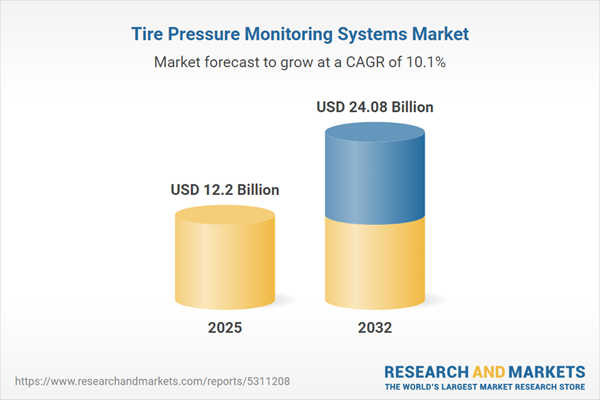Speak directly to the analyst to clarify any post sales queries you may have.
The Tire Pressure Monitoring Systems (TPMS) market is entering a dynamic phase, driven by technology integration and changing regulatory demands. Senior decision-makers seeking actionable market intelligence will find detailed, segment-focused insights to guide strategic planning and long-range investments in TPMS innovation, supply chain management, and global expansion.
Tire Pressure Monitoring Systems Market Snapshot
The tire pressure monitoring systems market grew from USD 11.17 billion in 2024 to USD 12.20 billion in 2025, and is projected to reach USD 24.08 billion by 2032 at a CAGR of 10.07%. This robust expansion reflects significant regulatory momentum for automotive safety and efficiency. TPMS adoption is accelerating in response to mandates in North America and Europe, as well as alignment with international standards in Asia-Pacific. OEMs, service networks, and technology suppliers are prioritizing TPMS investments to capitalize on evolving demand and compliance requirements.
Scope & Segmentation of the Tire Pressure Monitoring Systems Market
This comprehensive study provides deep analysis of the TPMS market, outlining technology trends, component advancements, and global deployment strategies. It delivers detailed segmentation to support informed decision making:
- Product Types: Direct TPMS, Hybrid TPMS, Indirect TPMS
- Key Components: Antenna, ECU, Sensors, TPM Warning Lights, Transceivers
- Sales Channels: Aftermarket, OEMs
- End Users: Automotive Manufacturers, Service Providers, Tire Equipment Suppliers
- Vehicle Types: Passenger Vehicles, Two-Wheelers, Heavy Commercial Vehicles, Light Commercial Vehicles
- Regional Segments: Americas (United States, Canada, Mexico, Brazil, Argentina, Chile, Colombia, Peru), Europe (United Kingdom, Germany, France, Russia, Italy, Spain, Netherlands, Sweden, Poland, Switzerland), Middle East (United Arab Emirates, Saudi Arabia, Qatar, Turkey, Israel), Africa (South Africa, Nigeria, Egypt, Kenya), Asia-Pacific (China, India, Japan, Australia, South Korea, Indonesia, Thailand, Malaysia, Singapore, Taiwan)
- Leading Companies: Alps Electric Co., Ltd., Continental AG, DENSO CORPORATION, Sensata Technologies Inc, Pacific Industrial, Valor TPMS, Bartec Usa LLC, Delphi Technologies, DUNLOP TECH GmbH, NXP Semiconductors
Key Takeaways for Senior Leaders
- Direct TPMS technologies remain the preference for premium vehicles, while hybrid systems cater to broader market needs by balancing performance with cost considerations.
- Component innovation is central, especially advances in miniaturized sensors, energy-efficient transceivers, and reliable ECU integration, resulting in higher data accuracy and improved overall system reliability.
- OEMs and aftermarket channels pursue different value propositions; OEMs focus on assembly efficiency and integrated diagnostics, whereas aftermarket providers promote modularity and advanced service analytics.
- Evolution of regulatory frameworks in established and emerging markets continues to drive broader TPMS adoption, influencing development roadmaps and localization strategies across the value chain.
- Collaboration—between established manufacturers, technology start-ups, and service providers—enables integrated solutions and positions firms to address shifting compliance demands as well as diverse end-user needs.
- Regional diversity in market maturity requires tailored approaches: mature economies prioritize telematics integration, while fast-growing regions emphasize ease of deployment and aftermarket penetration.
Tariff Impact and Supply Chain Adaptation
Newly imposed U.S. tariffs in 2025 have reshaped sourcing strategies for TPMS components, particularly those imported from Asia. Many manufacturers are revising supply networks, pursuing nearshoring and regional partnerships to mitigate cost pressures and maintain market stability. These changes have prompted increased capital investments in new production facilities, recalibration of pricing models, and closer collaboration with alternative regional suppliers to maintain competitiveness and supply chain resilience.
Research Methodology & Data Sources
This report combines primary and secondary data collection with rigorous analysis. Stakeholder interviews spanning OEMs, service executives, and regulatory specialists inform the qualitative outlook. Quantitative analysis is supported by industry white papers, regulatory filings, and proprietary datasets, ensuring reliability and data alignment with market realities.
Why This Report Matters
- Guides strategic planning by clarifying market drivers, competitive positioning, and regulatory ramifications specific to TPMS.
- Enables effective investment prioritization in R&D, supply chain agility, and regional expansion through actionable, segment-level intelligence.
- Offers actionable insights to manage tariff challenges, align technology offerings with evolving standards, and optimize channel strategies for future readiness.
Conclusion
With increasing regulatory attention and rapid technological innovation, the tire pressure monitoring systems market presents new opportunities for agile, forward-looking organizations. Strategic adaptation to changing supply chain and compliance environments will be pivotal for long-term growth.
Additional Product Information:
- Purchase of this report includes 1 year online access with quarterly updates.
- This report can be updated on request. Please contact our Customer Experience team using the Ask a Question widget on our website.
Table of Contents
3. Executive Summary
4. Market Overview
7. Cumulative Impact of Artificial Intelligence 2025
Companies Mentioned
The companies profiled in this Tire Pressure Monitoring Systems market report include:- Alps Electric Co., Ltd.
- Continental AG
- DENSO CORPORATION
- Sensata Technologies Inc
- Pacific Industrial
- Valor TPMS
- Bartec Usa LLC
- Delphi Technologies
- DUNLOP TECH GmbH
- NXP Semiconductors
Table Information
| Report Attribute | Details |
|---|---|
| No. of Pages | 180 |
| Published | November 2025 |
| Forecast Period | 2025 - 2032 |
| Estimated Market Value ( USD | $ 12.2 Billion |
| Forecasted Market Value ( USD | $ 24.08 Billion |
| Compound Annual Growth Rate | 10.0% |
| Regions Covered | Global |
| No. of Companies Mentioned | 11 |









